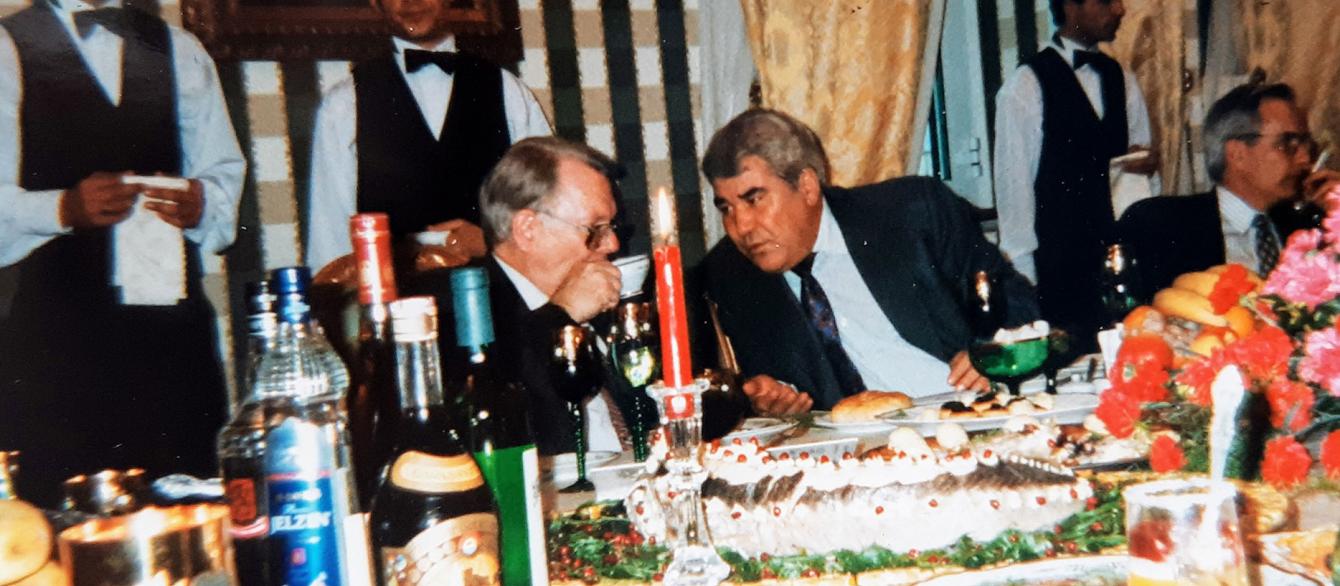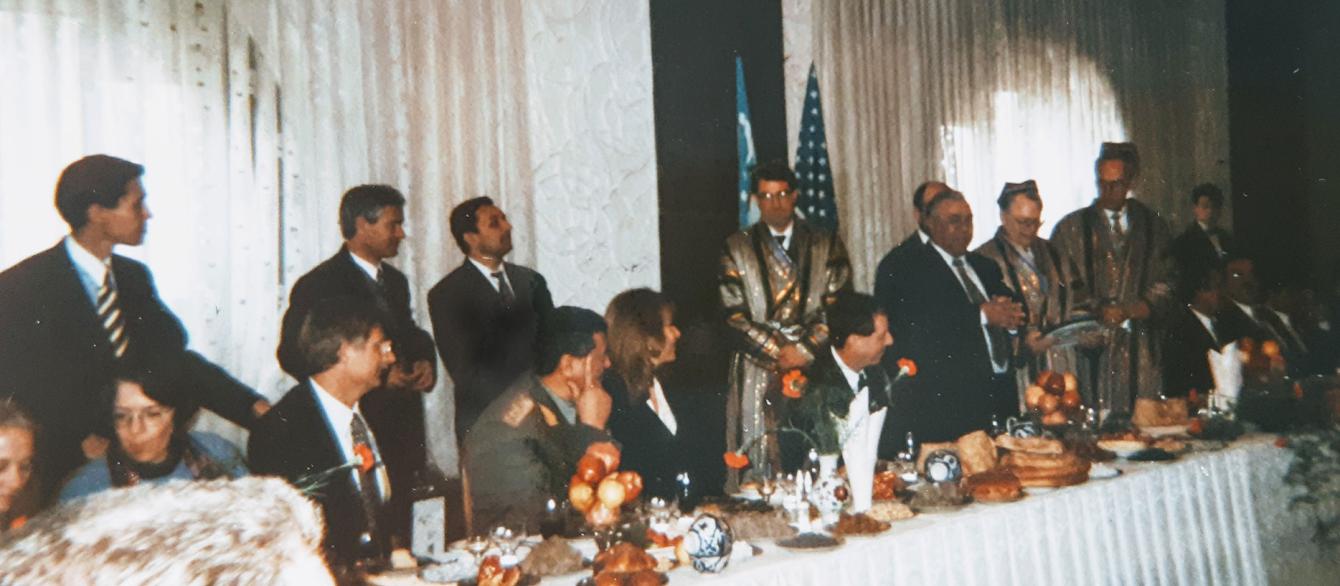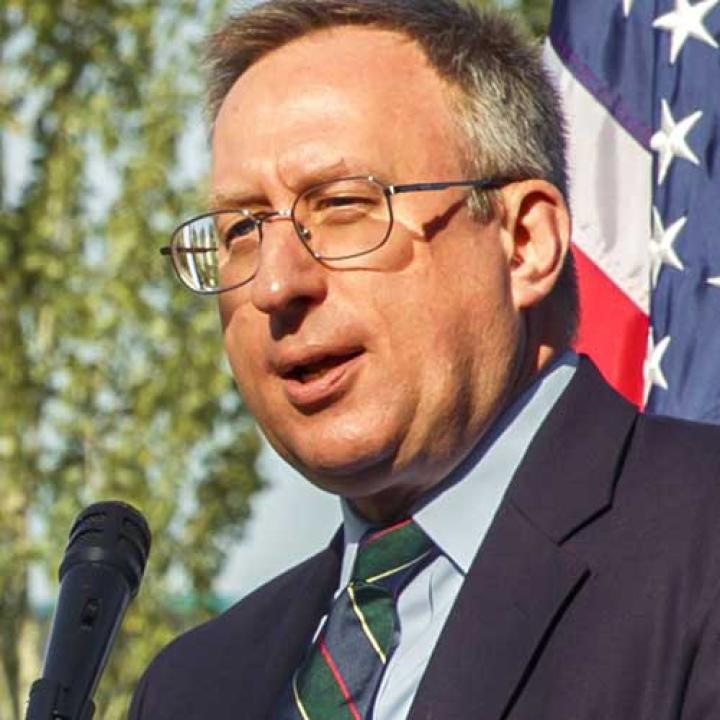This essay was originally published by Eurasianet.org as part of a series initiated and coordinated by Dr. Nagis Kassenova, director of our Program on Central Asia, in which retired U.S. diplomats share their experiences of working in the region during its early years of post-Soviet independence.
My first encounters with Central Asia occurred in 1995-1997 while I was serving as Special Assistant to Ambassador Jim Collins, the State Department’s Ambassador-at-Large for the New Independent States. Before assuming this position, I had witnessed the collapse of the Soviet Union working out of the U.S. Consulate in Leningrad/St Petersburg where I spent most of 1991 covering events in the Baltic republics. As the State Department rushed to establish diplomatic relations throughout the former USSR, I was assigned first to our new embassy in Kyiv, Ukraine, and then sent to Minsk, Belarus, where I served as Deputy Chief of Mission. Central Asia was therefore part of the Soviet Union I had never experienced first-hand.
Some background: In 1993 the Clinton Administration had created the office of Ambassador-at-Large for the New Independent States (or S/NIS as it was known in State Department jargon) to curate U.S. relations with Russia and the new republics that emerged from the former Soviet Union (except for the three Baltic Republics, which the U.S. government had never recognized de jure as part of the USSR.) Clinton’s Oxford roommate and Russia “specialist” Strobe Talbott occupied the new position until his appointment as Deputy Secretary of State in 1994. Career diplomat James Collins, an old Soviet hand, who had been Deputy Chief of Mission and Charge d’Affaires in Moscow when the USSR disintegrated, succeeded Talbott. Years before, as a very junior officer, I had worked under Collins in the State Department’s Operations Center, which Collins directed at the time. I suspect this may have factored into my selection as his special assistant as well as my experience working in Russia, Ukraine and Belarus.
By the time I arrived in the S/NIS office, we had established embassies and sent ambassadors to all five Central Asian states. Those first ambassadors were all career Foreign Service officers (and all male.) Nearly all had served in Moscow at one time or another with various degrees of Russian language ability. The sole exception was our first ambassador to Tajikistan, Stanley Escudero, who had not served in the USSR but was an Iran/South Asia hand and a fluent Farsi speaker (and an exceptionally gifted rug market negotiator.) I had served under him in New Delhi.

Collins conferring with Turkmenbashy over dinner in the Pink Palace.
Our first ambassadors to Central Asia were also serving for the first time as chiefs of their own mission. In fact, the collapse of the USSR and the opening of fourteen new embassies, boosted the careers of many officers, especially those with Soviet backgrounds. Otherwise, I doubt many of them would have achieved ambassadorships. The majority of officers serving in those first embassies were, like me, very junior, often with scant experience working in embassies, let alone new ones in new countries. At the time I thought the State Department foolish to send out so many inexperienced officers to set up new embassies in these tough places. I believed these posts needed more seasoned officers with greater hands-on foreign service management experience. But such was (and is) the Foreign Service assignment system. And yet, despite neglect from Washington and stuck at the tail end of the State Department’s supply chain, these pioneer diplomats, in true Foreign Service tradition, rose to the occasion to make do with what little they had, including experience, to set up our first missions and establish our first relations with the Central Asian peoples and governments that also lacked experience dealing with foreign diplomats and missions.
The U.S. Foreign Service at that time had no Central Asia experts. Strict travel controls Soviet authorities had placed on American diplomats in the USSR, plus the fact that much of Central Asia was closed to foreigners for “security” reasons, meant that few U.S. officers had visited the Central Asian republics except to accompany the odd U.S. Informational Exhibit through the region, or much later, under perestroika, when Embassy Moscow could send out officers as “circuit riders” to report from the previously sealed-off Soviet hinterlands. These “circuit riders,” who had been the brainchild of Ambassador Collins when he was in Moscow, were later sent out to start up our new missions and became the nucleus for the State Department’s expertise in the region.
A brief word about our first diplomatic premises in Central Asia: when the USSR fell, the State Department, or more specifically, the State Department’s former Office of Soviet Affairs, renamed the Office of the New Independent States, sent teams of officers to the new republics to establish diplomatic relations and set up rudimentary embassies. In Central Asia, as elsewhere in the former USSR, these first embassies were initially housed in hotels that would have struggled to receive even a quarter star for service or amenities, let alone be called hotels. Later, a State Department team led by former Washington real estate mogul (and a former ambassador to Hungary under President Reagan) Nicolas Salgo travelled to all the new republics to cut deals with host governments for embassy buildings. Most of the facilities he managed to secure had been premises that belonged to the Communist Party and its associated organizations.
Perhaps the most storied—and ugliest—U.S. embassy in Central Asia was the hideous “Soviet Moderne” style former Communist Youth Center in Tashkent. Its claim to fame was a tacky yet beloved disco ball that hung in the embassy cafeteria (the cherished ball now graces the Marine House located in the later built U.S. Embassy compound.) I recall our first embassy building in Almaty was an elegant 19th century merchant’s mansion that had passed through several incarnations in its Soviet past but whose stately rooms the State Department unfortunately replaced with cubicles and conduit. The new embassy in Ashgabat, on the other hand, was one of the State Department’s first and few fully prefabricated embassies brought in as containers and pieced together. It was clearly the most modern embassy facility we had in Central Asia at the time (sadly it is now the smallest and most overcrowded as efforts to build a new embassy as we have done everywhere else in the region have proven maddeningly difficult.) In return for our embassy buildings, the State Department helped the Central Asian governments find buildings in Washington for their new embassies. These were and remain to this day largely townhouses or elegant mansions, such as the Embassy of Uzbekistan on Massachusetts Avenue, formerly the Canadian Embassy.
Now from premises to policy: In 1995, when I joined the S/NIS office, official U.S. policy toward the new republics was, as it remains to this day, the holy mantra of “supporting each country’s sovereignty, independence, and territorial integrity.” Another key tenet in the U.S. policy catechism toward these republics that has endured to this day was to encourage them to “develop into multi-party democracies with market-based economies, at peace with their neighbors and responsible members of the international community of nations.” At the time, the U.S. pushed these republics to join international and trans-Atlantic organizations like the Organization for Security and Cooperation in Europe (OSCE) as a way of “locking in” their trajectory to the desired end-state of becoming prosperous market-based democracies that would respect the human rights of their citizens and fulfill all their obligations under international agreements and treaties. In fact, the U.S. conditioned diplomatic recognition of the republics on their written commitment to abide by all their obligations to international organizations and treaties to which they belonged as successor states to the Soviet Union. I doubt many of the republics knew at the time exactly what those obligations entailed, but since they all craved recognition, especially from the U.S., they gave us their commitment.

The lineup of U.S. ambassadors at the S/NIS chiefs of mission meeting held in Istanbul circa 1996.
Besides these high-sounding goals, U.S. policy toward Central Asia was also based on some real and immediate interests. Addressing security concerns topped the list of U.S. priorities in the former USSR, including in Central Asia. Dealing with the nuclear weapons and related facilities and resources the USSR had located in Central Asia was paramount. Few of the new governments themselves knew what facilities, weapons, and materials were on their territory as much of that information resided only in Moscow. However, we did know, for instance, that the main Soviet testing ground for its nuclear weapons was in Kazakhstan, which also possessed one of the world’s largest arsenals of strategic nuclear weapons after the USSR’s collapse. Tons of fissile material were scattered about in tunnels and research facilities. In Uzbekistan, a secret biological weapons research facility was located on an island in the Aral Sea (which has since become part of the mainland after the Aral Sea dried up.) To learn more about these facilities and help mitigate or eliminate their potentially threatening capabilities spurred the U.S. Department of Defense (DOD) to take an active lead within the U.S. government in developing relations with the new Central Asian governments. In addition, DOD wanted to influence the development and possibly the orientation of the militaries emerging in each republic.
Led by Senators Sam Nunn (D-GA) and Richard Lugar (R-IN), Congress made available to the Defense Department hundreds of millions of dollars under the Cooperative Threat Reduction (CTR) program to address these security challenges. This money underwrote the historic deal in 1994 that induced Kazakhstan (as well as Belarus and Ukraine) to transfer its strategic nuclear arsenal to Russia and join the Nuclear Nonproliferation Treaty as a non-nuclear state. The CTR program also included funding for the shipment of large amounts of bomb-making uranium out of Kazakhstan, under a program called Project Sapphire, as well as the clean-up of anthrax waste from the bio-weapon site on the “island” in the Aral Sea.
DOD’s CTR program far outstripped the monies available to the State Department in Central Asia. The Freedom Support Act Congress passed in 1992 provided the State Department a significant budget to help the former Soviet republics transition into functioning market-oriented democracies; however, most of that money was focused on programs in Russia, Ukraine and Armenia (which, despite its small size, enjoyed a strong lobby in Congress.) State Department-funded assistance programs in Central Asia were correspondingly small except for in Uzbekistan, which garnered a larger share of program funding because of its sizeable population and the thought at the time that Uzbekistan would eventually become the leading market-based democracy in Central Asia.
In addition to having more money than the State Department to spend in Central Asia, the Defense Department also enjoyed the luxury of having its own aircraft to visit the region. The virtual absence of commercial air links among the Central Asian states and the State Department’s own lack of dedicated aircraft forced State Department officials to rely on Defense colleagues to visit the region. My first visits to Central Asia with Ambassador Collins were accompanying then Assistant Secretary of Defense for Policy Ashton Carter, because he could get a U.S. Air Force plane to take us to all five republics. Carter was a generous host, but in light of whose plane it was, security issues colored the imagery and often dominated the agenda of these trips. On the other hand, these joint trips demonstrated to host governments State and Defense working hand-in-hand on common policy projection.

Krol with Ambassador James F. Collins wearing Uzbek traditional robes.
U.S. policy toward the former Soviet Union was, perhaps understandably, largely focused on Russia. Senior U.S. policy makers paid much less attention to the remaining successor states, especially those in Central Asia. Nevertheless, since Strobe Talbott, even as Deputy Secretary of State, essentially served as the Administration’s Russia desk officer, Jim Collins had a fairly free hand and more time to devote to the other former Soviet republics, including those of Central Asia. Collins was able to show the flag in Central Asia and, as he wryly put it, “tend the garden patch of these germinating democracies.” Still, our efforts to put Central Asia on U.S. policymakers’ agendas were often met with raised eyebrows or not so subtle derision (it was not uncommon to hear State Department colleagues refer to the Central Asian countries as the “icky-stans”). And so, while we paid lip-service to the idea of assisting the Central Asian countries in becoming part of “a Europe whole and free,” most Washington policy makers viewed the Central Asian republics much as Moscow authorities had viewed them in the USSR: exotic backwaters, not to be afforded the same treatment as the European republics.
At meetings of the OSCE and NATO’s Partnership for Peace initiative held in European capitals, our Euro-centric colleagues would view representatives of the Central Asia states as outsiders despite their membership in these organizations. Making fun of the shiny suits then favored by Central Asian officials, our colleagues and their European buddies would shake their heads at them and us before turning back to their lofty conversations conducted in the language we denizens of the former Soviet world termed “Eurobabble.” In Washington it seemed only the Defense Department, major American energy companies and human rights organizations took serious interest in the Central Asian region.
Now to the Central Asian republics themselves:
Uzbekistan enjoyed early cachet within the U.S. government and among U.S. businesses largely because, with the largest population in the region, and having been the transportation, economic, cultural, diplomatic and educational capital of Soviet Central Asia, Americans and most foreigners assumed Uzbekistan would re-assert its leading role in the region after the Soviet Union’s collapse. Uzbekistan indeed boasted impressive human capital, the savviest diplomats, significant natural resources and a surer sense of its own identity. Uzbekistan’s leadership at first embraced the U.S. relationship with openness if not enthusiasm. American visitors came away with the feeling that this was a serious country with a serious view of itself and the world around it. One could do business here. DOD officials considered Uzbekistan the only Central Asian country with the potential to become a key military power in the region and therefore worthy of significant U.S. investment.
To many American visitors, however, the major obstacle in the relationship with Uzbekistan was President Islom Karimov. Karimov was indeed a very serious man, but he put off American visitors, even in those early halcyon days, with long discourses on history (and everything else) and disparaging remarks about his neighbors. Americans often came to meetings with Karimov thinking they would do most of the talking; after all, they were coming to help Uzbekistan enter a new world based on our model, not listen to lectures from a Soviet-trained apparatchik. This chemistry did not bode well for future relations. Karimov’s personality, along with Uzbekistan’s largely go-it-alone policy, increasingly poor human rights record, and superior view of itself vis-à-vis the other republics made Uzbekistan an increasingly problematic partner for the U.S. One needed the right mix of respect and patience in dealing with Karimov. I will never forget Karimov’s gratitude to Collins for arranging, with great effort, a White House visit with President Clinton. Afterwards, an almost tearful Karimov told Collins; “Let me know what you want and I will do it for you.” That visit subsequently paid off in getting Karimov to ease up on some vexing issues including human rights.

Berobed Ambassador James F. Collins, Assistant Secretary of Defense Ash Carter and National Security Council Senior Director Coit D. (“Chip”) Blacker in Uzbekistan.
Kazakhstan, with its vast oil reserves, became an early favorite for U.S. policymakers and major American energy companies seeking to exploit Kazakhstan’s huge and untapped Caspian Sea energy potential. After granting Chevron access to Kazakhstan’s “oil patch” in the “Deal of the Century” signed in 1993, President Nazarbayev, in turn, adroitly used politically influential energy companies as sponsors in Washington to propel Kazakhstan—and himself—to the forefront of U.S. relations in the region. This included getting the Clinton Administration to agree to set up a Gore-Nazarbayev Commission that put Kazakhstan on par, at least symbolically, with Russia and its Gore-Chernomyrdin Commission, established between the Vice President and his Kremlin counterpart. Nazarbayev’s decision to relinquish the huge arsenal of nuclear weapons that remained in Kazakhstan after the USSR fell and to rid itself of most of the fissile material stored there also earned him and Kazakhstan high marks in Washington for partnership in nuclear non-proliferation efforts.
In meetings with senior American officials Nazarbayev showed particular skill in appearing to support U.S. policy requests without really committing to them. This tactic netted him, at virtually no cost, high profile meetings with U.S. presidents and visits to Kazakhstan from high-level U.S. officials. Nazarbayev’s considerable charm, humor, and gravitas, and his willingness to give his American visitors the floor, stood in sharp contrast to Karimov (who would angrily chide Americans for being taken in by “that nomad.”) Nazarbayev, however, made sure he had his say in meetings, especially to underscore to American visitors Kazakhstan’s delicate geographic and geopolitical position, precariously stuck between Russia and China. He would use this to justify his wariness of Kazakhstan becoming too democratic or too nationalistic lest either tendency overly antagonize these large and politically sensitive neighbors on whose good graces (and transit corridors) Kazakhstan’s existence as a state depended.
Turkmenistan’s immense gas reserves occasioned early high-level U.S. attention generated by American energy firms hoping to repeat the success they enjoyed in Kazakhstan. The Clinton Administration’s National Security Council also actively promoted a trans-Caspian pipeline linking Turkmenistan and Azerbaijan as part of an overall strategy ostensibly to diversify Central Asia’s energy flows, but was a thinly veiled euphemism for ending Russian pipeline dominance in the region.
President’s Niyazov’s coyness in discussions on opening Turkmenistan’s resources to American involvement and his personal hatred of Azeri leader Haider Aliyev clearly indicated the difficulty of reaching any deal on U.S. on-shore investment and the Trans-Caspian pipeline. Demonstrating the negotiating style of a rug merchant, Nizayov never said no (nor yes) to us and kept the cat and mouse game going, but his increasingly mercurial ruling traits and elevation of himself into the god-like “Turkmenbashy” gradually relegated Turkmenistan to the lower spectrum of American interests. Niyazov, however, was always charming to American visitors, hosting elaborate dinners and entertainments, bestowing gifts of Turkmen carpets, and even offering guests like Jim Collins one of Turkmenistan’s prized Ahal Teke horses (fortunately Ash Carter’s plane could not accommodate such a gift.) In the end, however, the gift rugs were usually all visitors had to show for their effort of travelling half away around the world to the land of the Turkmen.

Krol (right) with Deputy to the Ambassador-at-Large for the Newly Independent States (S/NIS) John E. Herbst in the S/NIS office.
Kyrgyz President Akayev’s rhetorical embrace of Thomas Jefferson made resource-poor Kyrgyzstan an early and somewhat constant darling of the U.S., especially among democracy and civil society promoters. Many in the State Department, USAID, and in the growing American non-governmental organization (NGO) community thought Kyrgyzstan would become a model of democracy for the rest of the region to emulate. At the very start of the relationship, however, our first ambassador to Bishkek, a rather eccentric yet brilliant old Soviet hand, reportedly had a less sanguine view of future ties. According to lore in diplomatic circles, the ambassador reported back to Washington that he could find nothing to interest the U.S in Kyrgyzstan, and suggested that the State Department should save taxpayer money and close the embassy. This advice reputedly earned him a one-way ticket home. Kyrgyzstan, or the Kyrgyz republic (as the Kyrgyz government insisted it be called, perhaps to emphasize the Kyrgyz national aspect of the republic despite, or to spite the large ethnic Uzbek population in the south,) quickly became a laboratory for U.S government-backed NGO civil society building projects. Akayev and his government initially welcomed the attention, the projects, and the expatriates, who came to run the programs. In time, Akayev’s family corruption and Akayev’s own reluctance to share power and influence began to cause friction with the U.S. and other donors. But that was still in the future. In the meantime, during our meetings the affable and professorial Akayev would always be sure to direct our attention to a bust of Jefferson in his office and extol the virtues of democracy while stressing that such polities cannot be built in a day.
In those early days, civil war-ridden Tajikistan rarely made it high on the U.S. policy agenda, until the U.S. later entered neighboring Afghanistan. In October 1992 the embassy was evacuated after fighting broke out in the capital Dushanbe and returned in March 1993. Even then, the economic and food situation was so dire that our first ambassador, who was an avid and experienced hunter, would supply the embassy with meat from animals he shot and butchered himself. Our embassy occupied a couple floors in a dilapidated hotel we shared with the Russian Embassy. I vividly recall my first flight to Dushanbe accompanying Collins and Carter aboard a U.S. Air Force plane as it swerved back and forth on its descent to evade possible missile attack. Once on the ground, our official meetings were solemn and short as our team, especially the Air Force plane crew, repeatedly checked their watches, anxious to head out to the airport for a departure that was as hair-raising as the landing.
There are many more stories I could tell of those early visits to Central Asia: of Uzbek tanks raining down from the skies over the cotton fields of the Ferghana Valley in a demonstration of Uzbek military power for our delegation, after which our hosts feted us with Uzbek plov and dancing girls; of a 22 course meal Turkmen President Niyazov hosted for us in his rose-colored palace with a huge jumbotron in the background loudly playing Road Runner and Yosemite Sam cartoons. Central Asia, it seems, was made for stories of wonder. But I must conclude this part of my tale. These were my first observations and experiences in Central Asia. Although I went back to working in Russia and later Belarus after my stint in the S/NIS office, the complexity of Central Asia’s history, its diverse societies and cultures, its fascinating if idiosyncratic leaders, and its layers of nuance continued to intrigue me. Little did I know then I would eventually find my way back to Central Asia where I would spend the last decade of my Foreign Service career as Deputy Assistant Secretary of State for the region and subsequently as ambassador to Uzbekistan and then Kazakhstan. But that’s for Part II of Through the Diplomat’s Looking Glass. See you then.






